 TravelINDIA.COM
TravelINDIA.COM
Shimla
the queen of hills
In the midst of the hills,
Lies the shimal of thrills!
home page
shimla lies in shivalik hill of lofty Himalayas,which have risen from the bed of prehistoric ocean Tethys.
it originated as 'shumlah' a small hamlet (extending from below St. Micheal's Cathedral to Ripon Hospital),
drawing water from natural mountain spring,now called 'Ram Mandir ki Baoli'.
Shimla was discovered in early ninteenth century by Gerard brothers.it grew out of the turmoils of Gurkha
Wars to become the summar capital of British india,described as 'WONDER TOWN'.so
famous it become, that a steamship company named it's liner'the city of shimla'.Now the capital of
Himachal Pradesh, it is india's Largest hill town.Engulfed inCHARM ROMANCE & GRANDEUR.
History
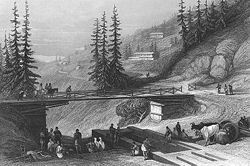 Most of the area occupied by present-day Shimla city was dense forest during the 18th century. The only civilisation was the Jakhootemple and a few scattered houses.[5] The area was called 'Shimla', named after a Hindu goddess, Shyamala Devi, an incarnation of Kali.[1]
The bridge connecting Shimla with Chhota Shimla, originally erected in 1829 by Lord Combermere, Shimla, 1850s
The area of present-day Shimla was invaded and captured by Bhimsen Thapa of Nepalin 1806. The British East India Company took control of the territory as per the Sugauli Treaty after the Anglo-Nepalese War (1814–16). The Gurkha leaders were quelled by storming the fort of Malaun under the command of David Ochterlony in May 1815. In a diary entry dated 30 August 1817, the Gerard brothers, who surveyed the area, describe Shimla as "a middling-sized village where a fakir is situated to give water to the travellers". In 1819, Lieutenant Ross, the Assistant Political Agent in the Hill States, set up a wood cottage in Shimla. Three years later, his successor and the Scottish[citation needed] civil servant Charles Pratt Kennedy built the first pucca house in the area in 1822, near what is now the Himachal Pradesh Legislative Assembly building. The accounts of the Britain-like climate started attracting several British officers to the area during the hot Indian summers. By 1826, some officers had started spending their entire vacation in Shimla. In 1827, Lord Amherst, the Governor-General of Bengal, visited Shimla and stayed in the Kennedy House. A year later, Lord Combermere, the Commander-in-Chief of the British forces in India, stayed at the same residence. During his stay, a three-mile road and a bridge were constructed near Jakhu. In 1830, the British acquired the surrounding land from the chiefs of Keonthal and Patiala in exchange for the Rawin pargana and a portion of the Bharauli pargana. The settlement grew rapidly after this, from 30 houses in 1830 to 1,141 houses in 1881.[5][6]
In 1832, Shimla saw its first political meeting: between the Governor-General William Bentinck and the emissaries of Maharaja Ranjit Singh. In a letter to Colonel Churchill, he wrote:
Most of the area occupied by present-day Shimla city was dense forest during the 18th century. The only civilisation was the Jakhootemple and a few scattered houses.[5] The area was called 'Shimla', named after a Hindu goddess, Shyamala Devi, an incarnation of Kali.[1]
The bridge connecting Shimla with Chhota Shimla, originally erected in 1829 by Lord Combermere, Shimla, 1850s
The area of present-day Shimla was invaded and captured by Bhimsen Thapa of Nepalin 1806. The British East India Company took control of the territory as per the Sugauli Treaty after the Anglo-Nepalese War (1814–16). The Gurkha leaders were quelled by storming the fort of Malaun under the command of David Ochterlony in May 1815. In a diary entry dated 30 August 1817, the Gerard brothers, who surveyed the area, describe Shimla as "a middling-sized village where a fakir is situated to give water to the travellers". In 1819, Lieutenant Ross, the Assistant Political Agent in the Hill States, set up a wood cottage in Shimla. Three years later, his successor and the Scottish[citation needed] civil servant Charles Pratt Kennedy built the first pucca house in the area in 1822, near what is now the Himachal Pradesh Legislative Assembly building. The accounts of the Britain-like climate started attracting several British officers to the area during the hot Indian summers. By 1826, some officers had started spending their entire vacation in Shimla. In 1827, Lord Amherst, the Governor-General of Bengal, visited Shimla and stayed in the Kennedy House. A year later, Lord Combermere, the Commander-in-Chief of the British forces in India, stayed at the same residence. During his stay, a three-mile road and a bridge were constructed near Jakhu. In 1830, the British acquired the surrounding land from the chiefs of Keonthal and Patiala in exchange for the Rawin pargana and a portion of the Bharauli pargana. The settlement grew rapidly after this, from 30 houses in 1830 to 1,141 houses in 1881.[5][6]
In 1832, Shimla saw its first political meeting: between the Governor-General William Bentinck and the emissaries of Maharaja Ranjit Singh. In a letter to Colonel Churchill, he wrote:
Culture
Shimla Ice Skating Club, which manages the rink, hosts a carnival every year in January, which includes a
fancy dress competition and figure skating events. Due to effects of global warming and increasing urban development
in and around Shimla,the number of sessions on ice every winter have been decreasing in the past few years.
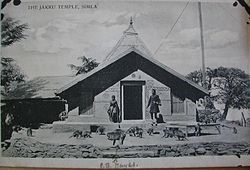 Jakhu Temple in 1910
Shimla has many temples and is often visited by devotees from nearby towns and cities. The Kali Bari temple,
dedicated to the Hindugoddess Kali is near the mall. Jakhoo Temple, for the Hindu god Hanuman is located at the
highest point in Shimla.Sankat Mochan, another Hanuman temple, is famous for the numerous monkeys that are always
found in its vicinity. It is located on Shimla-Kalka Highway about 10 kilometres (6.2 mi) from the city.
The nearby temple of Tara Devi is a place for performing rituals and festivals. Other prominent places of worship
include a Gurudwara near the bus terminus and Christ Church on the Ridge.
Jakhu Temple in 1910
Shimla has many temples and is often visited by devotees from nearby towns and cities. The Kali Bari temple,
dedicated to the Hindugoddess Kali is near the mall. Jakhoo Temple, for the Hindu god Hanuman is located at the
highest point in Shimla.Sankat Mochan, another Hanuman temple, is famous for the numerous monkeys that are always
found in its vicinity. It is located on Shimla-Kalka Highway about 10 kilometres (6.2 mi) from the city.
The nearby temple of Tara Devi is a place for performing rituals and festivals. Other prominent places of worship
include a Gurudwara near the bus terminus and Christ Church on the Ridge.
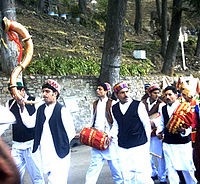 Shimla arts and crafts are highly in demand by the tourists. They range from excellent pieces of jewellery, embroidered
shawls and garments to leather made articles and sculptures. Shimla is full of pine and deodar trees. The wood has
been extensively used in all major buildings of Shimla. The various kinds crafts of Shimla made out of wood includes
small boxes, utensils, image carvings anat
Shimla arts and crafts are highly in demand by the tourists. They range from excellent pieces of jewellery, embroidered
shawls and garments to leather made articles and sculptures. Shimla is full of pine and deodar trees. The wood has
been extensively used in all major buildings of Shimla. The various kinds crafts of Shimla made out of wood includes
small boxes, utensils, image carvings anat
.
Climate
Shimla features a subtropical highland climate (Cwb) under the Köppen climate classification. The climate in Shimla is predominantly cool during winters and moderately
warm during summer. Temperatures typically range from -4 °C (25 °F) to 31 °C (88 °F) over the course of a year.
The average temperature during summer is between 19 and 28 °C (66 and 82 °F), and between -1 and 10 °C (30 and 50 °F) in winter. Monthly precipitation varies between
15 millimetres (0.59 in) in November and 434 millimetres (17.1 in) in August. It is typically around 45 millimetres (1.8 in) per month during winter and spring, and
around 175 millimetres (6.9 in) in June as the monsoon approaches.
The average total annual precipitation is 1,575 millimetres (62 in), which is much less than most other hill stations but still much heavier than on the plains.
Snowfall in the region, which historically has taken place in the month of December, has lately (over the last fifteen years) been happening in January or early
February every year.
The maximum snowfall received in recent times was 38.6 centimetres (15.2 in) on 18 January 2013. On two consecutive days (17 and 18 January 2013), the town received
63.6 centimetres (25.0 in) of snow.

Tourism
The Ridge:
The Ridge is a large open space, which is situated alongside the Mall Road andhosts all the cultural activities in the city. Christ Church,
The State Library and Gaiety Heritage Cultural Complex area some of the notable buildings located here.
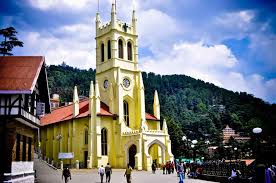
Christ Church:
Situated on the Ridge, Christ Church is the second oldest church in
Northern India.Inside there are stained glass windows which represent faith, hope, charity, fortitude, patience and humility.
Jakhoo:
2 km from Shimla, at a height of 8,000 ft, Jakhu Hill is the highest peak in
the city and has views of the city.
and of the snow-covered Himalayas. At the top of the hill is an old temple of Lord Hanuman, a Hindu deity which is popular
among tourists and locals alike. A 108 feet (33 metre) statue of Lord Hanuman, at 8,500 feet (2,591 metres) above sea level, is the statue standing at the highest
altitude among several other masterpieces in the world, overtaking the Christ Redeemer in Rio de Janeiro, Brazil.

jakhu Ropeway:
This ropeway connects Jakhu temple to the ridge ground and is the first ropeway in Shimla.
Jutogh:
Located 8 km from the city centre, this army cantonment is near Totu, an
important suburb of Shimla city.
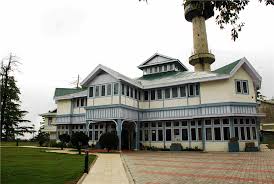
Shimla State Museum:
The museum, which was opened in 1974, has tried to protect hill-out and the cultural wealth of the state. here is a collection of miniature Pahari paintings, sculptures, bronzes wood-carvings and also costumes, textiles and jewellery of the region.
Indian Institute of Advanced Study:
This institute is housed at the former Viceregal Lodge, built in 1884–88.
Summer Hill:
The township of Summer Hill is at a height of 6,500 ft on the
Shimla-Kalka railway line. Mahatma Gandhi lived in these quiet surroundings during his visits to Shimla. Himachal Pradesh University is situated here.
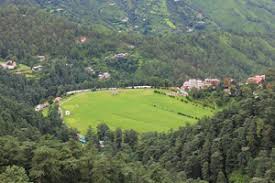
Annandale:
Developed as the racecourse of Shimla, Annandale is 2–4 km from the Ridge at a height of 6,117 ft. It is now used by the Indian Army.
Tara Devi:
11 km from the Shimla bus-stand. Tara Devi Hill has a temple dedicated to thegoddess of stars on top of the hill. There is a military Dairy Town here as well as the headquarters of Bharat Scoutsand Guides.
Sankat Mochan:
It is a famous Hindu temple dedicated to Lord Hanuman.

Junga:
Junga is nearest Tehsil, 26 km from Shimla. Its original name (with diacritics)is "Junga", and it is a former royal retreat of the princely state of Keonthal. It is known as the Keonthal Estate.
Anand Vilas:
Midway between Shimla and Junga. "Sarva Dharma Mandir", Temple of all faiths, is a spiritual group dedicated to Mother Nature. Thousands of visitors and devotees come here every year.There is an "Art is Values" school with pupils from all over India. Classes are provided free of cost.
Totu:
A major suburb of Shimla on NH-88. Houses Jutogh railway station &
HimFed under Govt. of Himachal Pradesh.
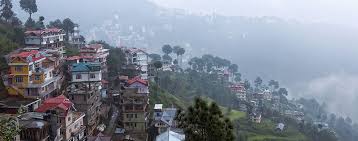
Mashobra:
13 km from Shimla, site of the annual Sipi fair in June.
Kufri:
16 km from Shimla at a height of 8,600 ft, Kufri is the local winter sports centre, and has a small zoo.
Chharabra:
13 km from Shimla on route to Kufri.
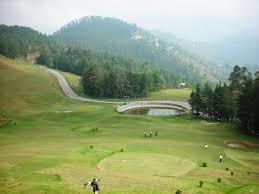
Naldehra:
22 km from Shimla, with a nine-hole Naldehra Golf Club.The annual Sipi fair in June is held in Naldehra
.
Food
Shimla famous foods has a very little global presence. Due to its location (topography), most areas have unique and influensive tastes.The food eaten normally is
very simple and comprises of a lentil, rice, vegetables and roti. Due to the climate of the region, food here provides warmth and strength.
Some of the Shimla famous foods are –

Channa Madra
Being served in almost all festivals, it is a very famous Himachali cuisine.It’s thick, yogurt based gravy made out of generally white or black chick peas. It is
served with rice or white bread. Dry fruits are also added to it for taste enhancement . You can find this item at places in and around Shimla.
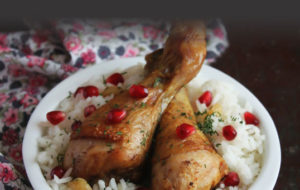
Chicken Anardana
This is a delicious chicken dish. Though it looks heavy but in reality it’s just the ground anardana (dry pomegranate seeds).They add the tang and spices to
the dish to make it more delicous.It is served with paranthas or triangle flatbreads.
to lose oneself in its lore and legend, Whispering pines, mists and mountains,
Snowy peaks,
Myriad shade of pahariculture.
 Most of the area occupied by present-day Shimla city was dense forest during the 18th century. The only civilisation was the Jakhootemple and a few scattered houses.[5] The area was called 'Shimla', named after a Hindu goddess, Shyamala Devi, an incarnation of Kali.[1]
The bridge connecting Shimla with Chhota Shimla, originally erected in 1829 by Lord Combermere, Shimla, 1850s
The area of present-day Shimla was invaded and captured by Bhimsen Thapa of Nepalin 1806. The British East India Company took control of the territory as per the Sugauli Treaty after the Anglo-Nepalese War (1814–16). The Gurkha leaders were quelled by storming the fort of Malaun under the command of David Ochterlony in May 1815. In a diary entry dated 30 August 1817, the Gerard brothers, who surveyed the area, describe Shimla as "a middling-sized village where a fakir is situated to give water to the travellers". In 1819, Lieutenant Ross, the Assistant Political Agent in the Hill States, set up a wood cottage in Shimla. Three years later, his successor and the Scottish[citation needed] civil servant Charles Pratt Kennedy built the first pucca house in the area in 1822, near what is now the Himachal Pradesh Legislative Assembly building. The accounts of the Britain-like climate started attracting several British officers to the area during the hot Indian summers. By 1826, some officers had started spending their entire vacation in Shimla. In 1827, Lord Amherst, the Governor-General of Bengal, visited Shimla and stayed in the Kennedy House. A year later, Lord Combermere, the Commander-in-Chief of the British forces in India, stayed at the same residence. During his stay, a three-mile road and a bridge were constructed near Jakhu. In 1830, the British acquired the surrounding land from the chiefs of Keonthal and Patiala in exchange for the Rawin pargana and a portion of the Bharauli pargana. The settlement grew rapidly after this, from 30 houses in 1830 to 1,141 houses in 1881.[5][6]
In 1832, Shimla saw its first political meeting: between the Governor-General William Bentinck and the emissaries of Maharaja Ranjit Singh. In a letter to Colonel Churchill, he wrote:
Most of the area occupied by present-day Shimla city was dense forest during the 18th century. The only civilisation was the Jakhootemple and a few scattered houses.[5] The area was called 'Shimla', named after a Hindu goddess, Shyamala Devi, an incarnation of Kali.[1]
The bridge connecting Shimla with Chhota Shimla, originally erected in 1829 by Lord Combermere, Shimla, 1850s
The area of present-day Shimla was invaded and captured by Bhimsen Thapa of Nepalin 1806. The British East India Company took control of the territory as per the Sugauli Treaty after the Anglo-Nepalese War (1814–16). The Gurkha leaders were quelled by storming the fort of Malaun under the command of David Ochterlony in May 1815. In a diary entry dated 30 August 1817, the Gerard brothers, who surveyed the area, describe Shimla as "a middling-sized village where a fakir is situated to give water to the travellers". In 1819, Lieutenant Ross, the Assistant Political Agent in the Hill States, set up a wood cottage in Shimla. Three years later, his successor and the Scottish[citation needed] civil servant Charles Pratt Kennedy built the first pucca house in the area in 1822, near what is now the Himachal Pradesh Legislative Assembly building. The accounts of the Britain-like climate started attracting several British officers to the area during the hot Indian summers. By 1826, some officers had started spending their entire vacation in Shimla. In 1827, Lord Amherst, the Governor-General of Bengal, visited Shimla and stayed in the Kennedy House. A year later, Lord Combermere, the Commander-in-Chief of the British forces in India, stayed at the same residence. During his stay, a three-mile road and a bridge were constructed near Jakhu. In 1830, the British acquired the surrounding land from the chiefs of Keonthal and Patiala in exchange for the Rawin pargana and a portion of the Bharauli pargana. The settlement grew rapidly after this, from 30 houses in 1830 to 1,141 houses in 1881.[5][6]
In 1832, Shimla saw its first political meeting: between the Governor-General William Bentinck and the emissaries of Maharaja Ranjit Singh. In a letter to Colonel Churchill, he wrote:
 Jakhu Temple in 1910
Shimla has many temples and is often visited by devotees from nearby towns and cities. The Kali Bari temple,
dedicated to the Hindugoddess Kali is near the mall. Jakhoo Temple, for the Hindu god Hanuman is located at the
highest point in Shimla.Sankat Mochan, another Hanuman temple, is famous for the numerous monkeys that are always
found in its vicinity. It is located on Shimla-Kalka Highway about 10 kilometres (6.2 mi) from the city.
The nearby temple of Tara Devi is a place for performing rituals and festivals. Other prominent places of worship
include a Gurudwara near the bus terminus and Christ Church on the Ridge.
Jakhu Temple in 1910
Shimla has many temples and is often visited by devotees from nearby towns and cities. The Kali Bari temple,
dedicated to the Hindugoddess Kali is near the mall. Jakhoo Temple, for the Hindu god Hanuman is located at the
highest point in Shimla.Sankat Mochan, another Hanuman temple, is famous for the numerous monkeys that are always
found in its vicinity. It is located on Shimla-Kalka Highway about 10 kilometres (6.2 mi) from the city.
The nearby temple of Tara Devi is a place for performing rituals and festivals. Other prominent places of worship
include a Gurudwara near the bus terminus and Christ Church on the Ridge.
 Shimla arts and crafts are highly in demand by the tourists. They range from excellent pieces of jewellery, embroidered
shawls and garments to leather made articles and sculptures. Shimla is full of pine and deodar trees. The wood has
been extensively used in all major buildings of Shimla. The various kinds crafts of Shimla made out of wood includes
small boxes, utensils, image carvings anat
Shimla arts and crafts are highly in demand by the tourists. They range from excellent pieces of jewellery, embroidered
shawls and garments to leather made articles and sculptures. Shimla is full of pine and deodar trees. The wood has
been extensively used in all major buildings of Shimla. The various kinds crafts of Shimla made out of wood includes
small boxes, utensils, image carvings anat








